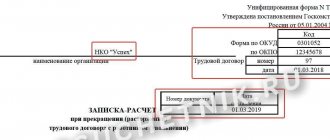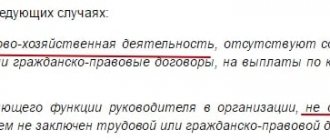Journal-order form of accounting
The form of accounting in which all data on business transactions is taken into account and systematized in journals for recording business transactions is called journal-order.
The basic principles are:
- Entries are made exclusively on credit accounts, indicating correspondence on debit.
- Synthetic and analytical accounting records are combined in a single accounting system.
- Data is reflected in accounting documents in the context of indicators necessary for control and reporting.
- You can apply combined journals to related accounts.
- You can create them monthly.
It is not necessary to use this form of accounting. An organization can keep records using a memorial order form, which is based on drawing up memorial orders for each business transaction. This type has a number of disadvantages: a significant lag between analytical accounting and synthetic accounting, as well as increased labor intensity: you have to duplicate records several times.
Why do you need a business transaction log?
An example of filling out this accounting register clearly demonstrates what operations were carried out and in what period. Documenting the business operations of an organization and considering them together allows a competent economist to analyze the current situation in the company, monitor its financial condition, predict future changes, draw conclusions and make efforts to stabilize the economic health of the organization.
Thus, documenting business transactions and maintaining accounting records are inextricably linked concepts that ensure the transparency and legality of business transactions.
You can find more complete information on the topic in ConsultantPlus. Free trial access to the system for 2 days.
Magazine forms
For public sector employees, the Ministry of Finance developed and recommended unified forms (Orders No. 123n dated September 23, 2005 and No. 25N dated February 10, 2006). But it is not necessary to use them (No. 402-FZ dated December 6, 2011). The organization has the right to independently develop and approve forms for accounting journals. But for this they should be approved by a separate order of the manager or in the form of an appendix to the accounting policy.
Cash accounting
The more compelling reason why we have placed so much emphasis on the simple system is that it opens the door to the cash method. Traditional accounting through double entry on correspondent accounts is not suitable for implementing such an accounting policy.
The use of the cash method is also interesting because tax accounting is carried out using this method “in a simplified manner” (with the object of taxation “income minus expenses”). In order to optimize accounting, we will supplement the simple entry register with columns from the book of income and expenses. The result will be a “two in one” form (Table 5) - like a universal transfer document, which many accountants liked.
Now about the main subtlety of the cash method, which eludes the understanding of many specialists. It deals with the recognition of paid income and expenses solely in the income statement. The fact of paying the costs involved in the formation of the asset will not affect its properties listed in the Concept (clause 7.2, 7.2.1). Consequently, the approach to preparing the balance sheet will not change.
Table 6 describes the same operations as in Table 5 with the difference that income and expenses are recorded by payment.
In Table 6, when determining the financial result of an activity, profit for the reporting period is calculated as the difference between income and expenses (clause 7.7 of the Concept). However, in the cash method there is no longer a link between net profit and capital. Therefore, in Table 6, capital is defined as the difference between the amount of assets and liabilities as of the reporting date (clause 7.4 of the Concept).
You probably noticed that the net profit figures displayed in tables 5 and 6 differ significantly (150 and 460 thousand rubles, respectively). However, it is the net profit that is subject to distribution among the company’s owners, regardless of the method by which it was obtained. Its amount is taken from the line “Net profit (loss)” of the financial results statement, provided for by the regulatory legal act. Once you have chosen the cash method, you should not identify net profit through additional calculations. However, when allocating dividends, it is necessary to comply with the restrictions established for net assets (Article 29 of the Federal Law of February 8, 1998 No. 14-FZ “On Limited Liability Companies”). So in the described situation it is impossible to pay more than 150 thousand rubles.
The author is not advocating the adoption of a simple system or cash method. These accounting policy options do not correspond to established stereotypes, and also do not exempt from the need to apply PBU. However, it is possible that the described methods will indeed seem simplified to some.
Guide for the simplified tax system
Since 2013, companies using the simplified tax system have been forced to conduct accounting. The book will help the accountant understand how to draw up a balance sheet and coordinate all reporting forms. Find out more >>
List of current journals
State employees use these types.
| Magazine number | Type of operations |
| №1 | Cash desk and cash flow |
| №2 | Bank current accounts |
| №3 | Calculations with accountable persons |
| №4 | Settlements with suppliers and contractors |
| №5 | settlements with debtors on income |
| №6 | Calculations for wages, scholarships, allowances |
| №7 | Disposal and transfer of non-financial assets |
| №8 | Settlements for other transactions |
| №9 | Validation |
Non-profit organizations use others.
| Name of journal-order | Contents of operations |
| JO No. 1 | Cash flow at the institution's cash desk |
| JO No. 2 | Current accounts |
| JO No. 3 | Special bank accounts |
| JO No. 4 | Payments for loans and borrowings (short-term and long-term) |
| JO No. 6 | Settlements with suppliers and contractors |
| JO No. 7 | Calculations with accountable persons |
| JO No. 8 | Calculations for taxes and fees, intra-business transactions, calculations for advances |
| JO No. 10 | Primary production |
| ZhO No. 11 | Accounting for finished products (goods, works or services) |
| JO No. 12 | Accounting for target financing |
| ZhO No. 13 | Fixed assets and depreciation |
| JO No. 15 | Retained earnings (uncovered loss) |
| JO No. 16 | Investment in non-current assets |
Form, content and format
Thanks to this magazine, the overall financial condition of the company is monitored, all changes for the worse or better are shown and forecasts are made for the further development of the company.
A competent and conscientious economist, based on this documentation, will also be able to predict ways for the best development of the company and solutions to certain problems, if any are discovered.
All documents do not always reach the accountant on time and not always in the form required by law. Then you have to create documents either from oral retelling or independently. Officially, such actions are prohibited, but in practice they are used quite often.
It is important that documents can be changed or edited retroactively, and that all these changes do not affect further operations. A business transaction journal is created based on primary documentation.
Journaling and accounting are directly related to each other and guarantee the company the transparency and legitimacy of all operations carried out in the company, since the document displays all changes in the company’s business activities, such as:
- Change in assets (any change in equipment that helps produce a firm's product, whether it is broken, replaced, or repaired).
- Changes in liabilities (actions with loans and securities).
- Positive changes in the general condition of the company (assets, liabilities and financial condition).
- Negative changes in the general condition of the company (assets, liabilities and financial condition).
- Certain facts that do not fall into any of the above categories (other changes).
[docs]
Some enterprises additionally indicate in the journal primary documents that affect the movement of funds.
Features of the formation of accounting registers
Law No. 402-FZ establishes mandatory requirements for accounting documentation. Regardless of what type of form was chosen by the organization: unified or developed independently.
Mandatory register details:
- The name of the document and its form.
- Full name of the institution.
- Start date and end date of journal entries. The period for which it was formed.
- Type of grouping of accounting objects (chronological or systematic grouping).
- Indication of the unit of measurement of accounting objects, or the monetary value of the measurement.
- Indication of officials responsible for maintaining the register.
- Signatures of responsible persons.
Registration logs are compiled on paper or electronically. For the latter, you will need an electronic signature to certify the document. Without a signature (electronic or handwritten), the journal order is considered invalid.
Corrections are permitted. They can only be entered by the person responsible for maintaining the journal. Next to it, you should indicate the date and certify the correctional entry with a signature, with a description of the position and full name of the person responsible.
Results
The register containing complete information about the activities of the organization, reflected in the accounting accounts, can be called the “Journal of business transactions” (or transactions, or facts of economic activity - this will not change its function). Modern accounting software allows you to create such a register automatically, which can help you find the necessary records in a large amount of information by applying filters and sorting.
Sources
- https://spravochnick.ru/buhgalterskiy_uchet_i_audit/suschnost_i_soderzhanie_buhgalterskogo_ucheta/zhurnaly_operaciy/
- https://ZnayBiz.ru/buh/raznoe/otchetnost/zhurnal-hozyajstvennyh-operacij.html
- https://okbuh.ru/buhgalteriya/zhurnal-hozyajstvennyh-operatsij-obrazets
- https://nalog-nalog.ru/buhgalterskij_uchet/vedenie_buhgalterskogo_ucheta/zapolnyaem_zhurnal_ucheta_hozyajstvennyh_operacij_obrazec/
- https://gosuchetnik.ru/shablony-i-formy/oformlyaem-zhurnal-khozyaystvennykh-operatsiy
- https://FBM.ru/bukhgalteriya/dokumenty/zhurnaly/chto-takoe-zhurnal-khozyajjstvennykh-opera.html
- https://eat4fun.ru/egrp/17202-zhurnal-khozyaystvennykh-operaciy-obrazec-zapolneniya-s-provodkami.html
- https://minakovajulia.ru/zhurnal-hozyajstvennyh-operatsij/
Filling rules
Each magazine has its own filling requirements. Let's take a closer look at the basic filling rules.
Journal of registration of incoming and outgoing cash orders (JO No. 1)
We make entries based on the cashier’s report, confirmed by the relevant documents (RKO and PKO) at the end of the working day. If movements at the cash register are insignificant, it is allowed to make entries in the register 3-5 days in advance, according to several reports at the same time. Then in the “Date” field we indicate the period for which we are making records. For example, 3-6 or 20-23.
Magazine order 2
Entries are made on the basis of bank statements and other supporting documents (checks, personal account statements). It is allowed to make one entry on several bank statements. In this case, in the “date” field, be sure to indicate the start and end date of the statements.
Magazine order 6
We fill out the register based on documents confirming settlements with suppliers and contractors. Merging records is not allowed. The final balances of the previous period are transferred to the next register, in the “Balance at the beginning of the month” field.
Magazine order 7
We register settlements with accountable persons. We make separate entries for each advance report. Concatenation or grouping of rows is not allowed.
Magazine order 8
We indicate data for each operation:
- advance payments and settlements with contractors and suppliers (issued and received);
- settlements with budgets for taxes and fees;
- settlements with various creditors and debtors;
- on-farm operations.
Magazine order 10
We make records of expenses for our own production, in the context of each business transaction (depreciation, wages of production personnel, materials, deferred expenses, etc.).
Journal warrant 11
We reflect data on accounting of finished products. It is allowed to enter generalized information. The form of the journal is developed by the organization independently, taking into account the specific features of the activity (production).
How to fill out a business transaction journal
Typically, an accountant, having completed an entry in the accounting documents, makes a corresponding entry in the journal. We present the journal of business transactions (sample filling with postings).
| No. | date | No. w/o No. first document | Household contents operations | Account correspondence | Sum | Signature | |
| D/t | K/t | ||||||
| 1 | 10.01 | J/o No. 1 PKO No. 1 of 2016 | Receipt from account: — for a salary of 150,000 rubles; - household needs 2,000 rubles; — travel allowances 15,000 rubles. | 50 | 51 | 167 000 | |
| 2 | 10.01 | RKO No. 1 | Salary was issued according to wages. No. 1 | 70 | 50 | 150 000 | |
| 3 | 10.01 | RKO No. 2 | Issued on account to the owner. needs | 71 | 50 | 2 000 | |
| 4 | 10.01 | RKO No. 3 | An advance was issued for travel expenses | 71 | 50 | 15 000 | |
| 5 | 13.01 | PKO No. 2 | Received proceeds from sales from the tray | 50 | 62 | 28 000 | |
| 6 | 13.01 | RKO No. 4 | The proceeds were transferred to the bank account | 51 | 50 | 28 000 | |
In the third column of the journal, the accountant makes a note on the primary accounting form, which documents the fact of the business transaction . It is also not forbidden to refer to the order journal, where you can see the posting of interest. The record of the actual transaction should be clear and concise.
Directories and check routines
1.1. Chart of accounts - directory of accounting accounts. The chart of accounts is linear, that is, it consists of a list of subaccounts. The entire account is highlighted using whole numbers. For subaccounts 68.1,68.2, etc. main account 68. 1.2. Subkonto - directories of analytical accounting objects (directory of third-party organizations and individuals, directory of employees). Subconto is an analytical feature used for calculations. Calculations for accounts with an expanded balance are made taking into account the balances of the subaccount. Attention ! For accounts 60,76,62,75 - the subconto should be “Directory of organizations and individuals. persons." For account 70 - subconto only from the “Workers” directory. For account 71, the required subconto is “Employee of the Enterprise”; in addition, the subconto from the “Organizations” directory can also be indicated. Check the activity log for the above errors. 1.3. Packaging and reindexing are standard items in the main menu of any task. Packing reduces the number of records in databases by removing those marked for deletion. Reindexing is performed in case of failures. For this system, reindexing is not a prerequisite for operation. 1.4 Constants. Here you enter constant data for each enterprise (TIN, codes, name of the tax office, and so on). 1.5 Programs for checking: the transaction log and the correctness of transactions. Successful verification of the transaction log is a necessary condition for the correctness of the calculations, so follow the recommendations issued by the verification program. Checking the correctness of transactions is one of the ways to find your erroneous transactions. Before checking, fill out the knowledge base in the “Settings” section.








